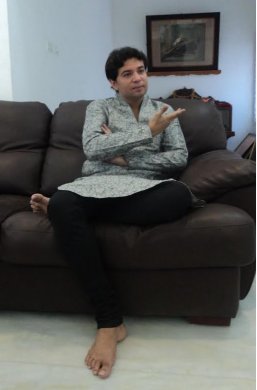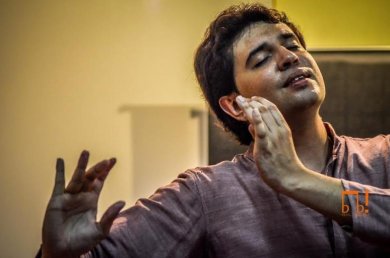
|
 |

|
 |
Aniruddha Knight: A dialogue on manodharma in dance - Ranee Kumar e-mail: ranee@journalist.com August 13, 2015  An evening with the illustrious Balasaraswati's only grandson, Aniruddha Knight and you feel enlightened on the most exceptional expression of dance-manodharma. A long forgotten feature with performing artistes of today's dance world, it was this very manodharma that made Balamma immortal. Aniruddha has proved to be a chip off the old block when it comes to a holistic approach to dance. He is an excellent musician with an expert ear for rhythm, imbibing the intricate nuances of dance with intuitive manodharma. What sets him apart from the rest of the performing dancers is the striking clarity in holding mudras that it is difficult to take one's eyes off his hands when he is performing. Excerpts from the conversation… What is manodharma in dance? Google throws up this subject only in Carnatic music? (Surfs his laptop for a minute and...) Sad! It doesn't even recognize something called manodharma exists in dance! It is a unique aspect of Indian art across the land. No one speaks of it anymore. Manodharma conveys a whole gamut of emotions intrinsic to holding the nritta, natya together. Technically you can screw up a dance and still get away with it; but that's not the case with manodharma. Without the emotive quotient your dance will fall flat on its face. Again not to be confused that manodharma is a standalone facet of dance. Technique is the backbone on which manodharma stands. In a nutshell, it is an art of suggestion through which an illusory world is created for the audience and for the dancer as well. Manodharma is not perfection in dance, it is excellence. Human body is palpable. A technically perfect dance can be awfully boring, but excellence contributes to an aesthetic experience, which is what Indian dance is all about. Does the traditional repertoire give scope for manodharma? The 'margam' was originally shaped in the way it is, because it is a gradual opening up of the dancer's mind That is when manodharma comes into play. In today's margam the intrinsic value of each piece is lost and the reason for this is we have mingled dance and music. The intensity of a teermanam (cyclic finale) as Kandappa Pillai or Ganesha Pillai composed, could be broken and translated onto footwork by the dancer. Today, the dancer is clueless as to the rhythmic breaks of a lengthy teermanam and is entirely dependent on the mridangist who can only spell out the 'sollu' not dance rhythm. With the decline of the nattuvanar, now replaced by just about anybody from senior student to vocalist, dance has fallen into a mechanical exercise in song and mime. What are the tools to be used to learn manodharma? Manodharma cannot be taught and learnt. It has to be imbibed almost at the end of dance learning process. It is a gradual evolution that happens after watching and watching your guru do it. It is improvisation in a structured manner since this is classical dance and we cannot ignore the precepts that have been laid down in the texts. Through the entire process of growing up, more so if you are a dancer, you absorb many things you see, hear and read. Even if these are forgotten momentarily, they come to the fore when you have to recreate a particular situation or character while performing. I would advise a lot of study; study of books not just on dance, but our ithihaasa and purana and to a certain extent our Indian philosophical thought. Busy schedules of work and lifestyle are no excuse. Indian classical dance is not just of the limbs or emotion; it has a rich background steeped in our scriptures. Once you are familiar with your heritage and tradition, you can translate it into dance with confidence. The tradition is our psyche and is bound to reflect in all that we do and express. This apart you need to have an innate sense of rhythm and be adept in music. There is no dance without music. My grandmother Balamma believed in the mundane process of learning over and over again, growing with it, adapting to it and then maturing with it. She would begin a new lesson by doing the abhinaya herself to the entire composition. The pupil would be asked to just watch her do it for the next one week or more, can never say. And with every day the expression would vary. Suddenly, without a warning, she would order the pupil to do it on her own. You can well imagine the pupil's dilemma. But then, believe me when I say, we would do our own abhinaya with varied expressions all by ourselves after the initial nervousness and come out fairly well. Over the days, we would have unknowingly absorbed all that the guru did and it gets reflected in our own. This is the only tool, so to say.  There is a lot of difference in the way you use your hands to form mudra and that of other dancers? In Balamma's school of dance and that means in Guru Kandappa Pillai's style, formation of mudra played a very vital role. It had to be crystal clear to the discerning viewer; the dancer had to take her eye along the hand to the mudra she held and then bring it back. There was no question of darting a fleeting glance at your own hand and then look at the audience and smile as you withdraw your mudra. The prayoga (usage) of each hastha (hand) had to be discerned while in the learning process itself. The mudra being used also had to have a topical relevance. The sensibilities had to be felt by the dancer. For instance, technically the 'alapadmam' (lotus) mudra is shown in a particular way like this (he demonstrates). But then this mudra when used has to be appropriate with the bhava (connotation) of the lyric to which you are presenting your dance. The same technical mudra of a lotus cannot be used to describe a 'lotus-eyed' or a 'lotus-born.' These finer nuances are intrinsic to manodharma. The impromptu improvisation on stage often leads to a pause and a graceful walk back as observed in your style. Doesn't that lead to an impression of gaps in a presentation rather than a continuous flow which would look more complete and aesthetic? Why should a spectator be inundated with dance all the time? We can give the audience a breather for sure! The pause is not an ugly gap. It allows the artiste to quickly make up the next pattern of expression in her/his mind as she/he walks back and waits for the mridangist to wind up with a finishing touch. Further, just like in music katcheri, the accompanists must be given time to showcase their individual virtuosity. Actually manodharma is a gradual ascension of ideas. One can't just take off on a tangent into the centre. The interpretation has a process; the sanchari are poetic ideas, not mere stories from Purana. Take the pooja murai (process) for instance. It is not a part of any Purana; it is a ritual that has to be visualised and experienced within the artiste herself/himself and reproduced in an aesthetic manner. Dance is not becoming the character portrayed but only suggesting the character. It is like a Picasso; the dancer's emotional expression suggests the persona of the character. The artiste should enjoy what he/she is doing, only then is the 'rasa' churned and makes for an aesthetic experience. Today choreography rules the roost in dance making for perfect presentations. Your take? As already mentioned, perfection and excellence in art are two different things. One is chiselled and handed over; the other is alive and pulsating with brilliance. Choreography was a part of the Western culture; they've been doing the same Ballet for 200 years without improvisation. It has tip-toed into our dance and has become the norm. This has happened with institutionalizing dance. How do you manage to teach 50 students dance at the same time? You literally spoon feed what you manufacture and a pre-digested food is a convenient way to avoid risk of indigestion. We fall back so much on choreography since it is a safety net. Both viewers and artistes need and choose the comfort zone. The former doesn't want to be haunted by artistic experience and the latter doesn't want anything but 'made to order' menu. It's like eating from Saravana Bhavan wherever it is placed. It is uniform every day. I cannot envisage a performance which has been rehearsed 100 times - adavus, hastha mudras, sancharis, emotions, et al. Doesn't that come out jaded on stage? How can 'rasa' be generated out of an aesthetically channelled art where there is nothing like spontaneity. The two juxtaposed, where are we? Pre-packaging (choreography) has its pitfalls. Any artiste's greatest fear is about hitting a plateau. Each performance should be like a push ahead. In manodharma one can't get on to the stage with pre-conceived notions. You learn and absorb but you enter the stage like an empty pot. Manodharma is like a double edged sword. The chances of success and failure are 50:50. But what sets a great and unique artiste from a mediocre one is the ability to be eloquent even on a day when emotion doesn't seem to work. Bala was able to create and recreate a song a 100 times. Therein lay her success and driving force. You can't see beauty all the time unless value is added to it; choreographed dance and manodharma respectively fall into this category. Once manodharma is in place in an artiste the dynamics of dance is bound to change. Contact Aniruddha Knight at: contact@aniruddhaknight.com Post your comments Unless you wish to remain anonymous, please provide your name and email id when you use the Anonymous profile in the blog to post a comment. All appropriate comments posted with name & email id in the blog will also be featured in the site. |